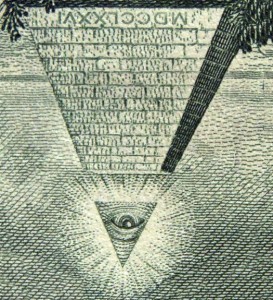Death to the inverted pyramid; life to alternative story forms
I have a hate/hate relationship with the inverted pyramid. I hate the fact that this artifice, created to deal with ancient mechanical issues, is still being justified to journalism students today based on ex post facto reasoning. And I hate the way alternative forms, often based on actual reader habits, are so often derided as pandering.
The inverted pyramid evil is embedded deep in the college students I’ve been teaching. I’m going to be speaking to a group of high school journalists this week at a regional meeting of the Ohio School Media Association, where I’ll hope that I can get to them before the pyramid’s roots sink too far down. If this doesn’t work, I may have to do a tour of day-care centers.
Here’s what I’ll be telling the OSMA students:
An inverted pyramid story jams the most important facts at the top and gets increasingly boring as it goes on. It wastes words trying to provide transitions between slightly related paragraphs. It hides its structure from the readers, making it harder for them to figure out what’s what. And it does not invite the readers to find their own stories within the information.
These alternative story forms can be used to solve many of the inverted pyramid’s flaws. However, just using an alternative form isn’t enough. You must use it well. That means:
- Keep the level of interest even from start to finish. Don’t pad a timeline with minor events.
- Write concisely. In a Who’s Who, don’t use full sentences when you can just list a title or briefly describe a job.
- Make the structure obvious. Use bold-facing so questions in FAQs or interview transcripts stand out from the answers.
- Let the reader become a participant. In a charticle, don’t just offer your opinions; provide facts so the readers can make their own decisions.
Different forms work best with different stories. Here are some suggestions for the types of questions each form can answer best.
 TIMELINE
TIMELINE
Highlight key moments arranged in chronological order.
How does the basketball team get ready for the season?
How was the current faculty put together?
Why is the school district budget in bad shape?
Tips: A timeline doesn’t have to be a literal line. Simply arrange information from start to finish so the reader can see how a story developed. This can be combined with aggregation in which linking allows the reader to dig even deeper, as I did when three women emerged after a decade of captivity in Cleveland.
 FAQ
FAQ
Ask and answer common questions.
How does scheduling for next year work?
Why do some kids get suspended and others get away with it?
What do I need to know about prom?
Tips: How do you figure out what the most frequently asked questions are? Ask your readers, or ask the people who end up having to answer them. With the Decade of Captivity story, we paid attention to what people kept asking in the comments under our stories.
 WHO’S WHO
WHO’S WHO
Provide short biographical information about key people and their connections to one another.
What do all those football coaches do on the sidelines?
How can I keep track of all the characters in “Once Upon a Time”?
Which administrator do I see if I have a particular problem?
Tips: Instead of just listing names, try a graphic format that adds information about who’s connected to whom. That gave readers more information about the relationships in the Decade of Captivity reporting.
 TICK-TOCK
TICK-TOCK
Tell a story from beginning to end, with or without specific times.
What happened to our classmate after she was in a car crash?
What’s it like to run a 10k?
What happens on the last day of school after all of us students leave?
Tips: A tick-tock can be written like a series of diary entries, with each entry headed by its time. But I’m also including simple chronological narratives, because they still break with the inverted pyramid rule of ordering facts by importance and giving away all the key facts in the first paragraph. There’s a reason “this happened, then that happened next” is a part of all our fairy tales and almost all great novels. It worked very well to allow people to understand the events and emotions when the women were released.
 LIST
LIST
Sum up important facts in 5-20 points (not necessarily in ranked order).
What’s different about the baseball team this year?
What new classes have been added to the curriculum?
What common freshman mistakes should I avoid?
Tips: Numbers suggest to the reader that a story has been boiled down to its essentials, and they promise a finite set of facts to consider. Don’t pick a number and then make up items to fill it, especially with serious stories. Let the content drive the list, as we did in helping readers keep up with each day’s swarm of news items about the newly free women.
 CHUNKY BITS
CHUNKY BITS
Sum up important facts without numbers.
What do I need to know about the new graduation requirements?
What are the strengths and weaknesses of this year’s volleyball team?
What’s the deal with the National Honor Society?
Tips: Subheads in your text break it up visually, making it seem shorter to the reader. They also allow you to dispense with transitions and simply skip from one key point to the next. The Associated Press made good use of chunky bits in offering advice on data privacy.
 DOCUMENT
DOCUMENT
Provide direct access to source material.
What were callers telling the police about that incident last week?
What’s in that new law regarding teen curfews?
What did last year’s valedictorian have to say that had people cheering?
Tips: Journalism is usually a filter between our sources and our readers. For many readers, that’s our value — we sift through the information, select the most important and sort it into some kind of order. But some readers want to get closer to the source. Especially since the internet essentially has no space limits, we can easily provide some of that direct access by posting original documents or recordings. One of the most-read posts in our coverage of the missing women just contained audio and a transcript of key 9-1-1 calls.
 ANNOTATED TEXT
ANNOTATED TEXT
Footnote documents.
What are your recommendations about next week’s cafeteria choices?
What will colleges see when they look at my transcript?
Why does the dress code ban things no one would wear anyway?
Tips: Get more sophisticated in your presentation of documents by using footnotes to add information or interpretation. This doesn’t only work with serious subjects. Why not annotate a popular song?
 ANNOTATED IMAGE
ANNOTATED IMAGE
Footnote photos, diagrams, maps or drawings.
What are the usual dinner spots before prom?
How much does it cost to protect a football player on the field, and does it work?
What’s all that stuff I see in Mr. Murphy’s office?
Tips: Providing boxes of information connected by lines to spots on a map or photo creates quick, easy graphics. Moving back and forth between the image and the text gets the reader involved in creating the story. The more the clutter, the more reason to annotate.
 QUOTES/TWEETS
QUOTES/TWEETS
Assemble written or spoken reactions.
How were fans coping with the back-and-forth in last weekend’s big game?
What happened during the debate between the two student council candidates?
What advice do our teachers have about doing well in college?
Tips: “Man-in-the-street” interviews have been around a long time, so the idea of collecting tweets to show what people are thinking isn’t some evil result of the internet. But avoid the temptation to select only the most outrageous quotes, or to suggest that a few angry tweet mean most people feel the same way. The core idea is that if the value of the content lies solely in what people said, providing a string of quotes saves a lot of space wasted on trying to connect those quotes with transitions. When Joan Rivers said something outrageous, a line of tweets made the point about what a stir she created.
 INTERVIEW TRANSCRIPT
INTERVIEW TRANSCRIPT
Print an unedited (or lightly edited) version of an interview’s questions and answers.
What are the new principal’s plans?
How cool is the alumna who’s now fronting a rock band?
Why is Mr. Murphy retiring so young?
Tips: The best subjects for a transcript (sometimes referred to as a Q&A) fall into two categories: People who have enough power that their exact words carry weight, and people who have interesting personalities best seen through their interaction with the questions. Case in point for the latter: Ozzy Osbourne.
 CHARTICLE
CHARTICLE
Use a grid to compare multiple items in multiple categories.
Who should I vote for as homecoming king and queen?
How much work will I have to do for my classes?
What are the best part-time jobs for a high school student?
Tips: Squeezing comparisons into a regular story forces the writer to pick one of two ways to package: collect all the information about each main entry together, so the reader has to jump from one section to another to compare all the entries on the same category; or collect all the information about a given category together, so the reader has to jump section to section to see the complete picture for a given main entry. A grid puts the reader in control; she can read across or down. It’s a common way to compare products nowadays, for good reason.


No Responses